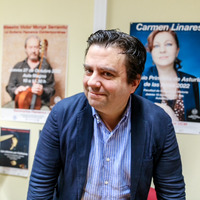
ELENA M A R T Í N MARTÍNEZ
Hace unos años reconduje mi carrera profesional que había iniciado en el año 2008 como bailaora de flamenco y directora de mi propia compañía – nacional e internacional -, hacia la gestión cultural en artes escénicas. Mi recorrido anterior – tanto a nivel de contactos, como de conocimiento hacia el sector –, mi experiencia después de haber vivido en Inglaterra e Italia, junto a las nuevas herramientas que me ofreció el máster, me llevó a trabajar con grandes figuras de la danza que han incrementado mi conocimiento y permitido seguir ampliando la red de contactos y conocimiento. La importancia que conlleva la cultura tanto a nivel social como económico, después de haberlo evidenciado personalmente y desarrollado en mi tesina de final de máster, me impulsa diariamente a seguir trabajando para posicionarla al lugar que merece
less
Related Authors
Eduardo Murillo
Universidad Complutense de Madrid
Iván Periáñez-Bolaño
Universidad de Sevilla
RAFAEL HOCES
Conservatorio Profesional de Música Ángel Barrios
Juan Manuel Arjona
Loyola Andalucía University
Manuel Angel Calahorro Arjona
Conservatorio Superior de Música de Córdoba
Diego García-Peinazo
Universidad de Córdoba
Trinidad Jiménez
Universidad de Sevilla
Daniel Gómez Sánchez
Universidad Complutense de Madrid









Uploads
Thesis Chapters by ELENA M A R T Í N MARTÍNEZ
Palabras clave: artes escénicas, danza, flamenco, Teatro Villamarta, Jerez de la Frontera.
The Jerez Festival has become an important economic and cultural engine for Jerez de la Frontera, as well as a relevant international showcase for flamenco. The cultural management model of this event, launched in 1996, has made it possible to highlight some of the characteristics of the city that hosts it, at the same time that it has acted as an active agent in the conservation and evolution of flamenco dances and Spanish dance. During its 24 editions, the festival has been growing and becoming more complex, in the same way that the artists participating and the number of attending public have increased also. The Jerez Festival has consolidated a successful management model. This work analyzes which are the variables that identify and determine this success. To do this, we will study its last 5 editions (2016-2020), paying attention to the fundamental axes of its design and to the strategies for connecting with the city and with the flamenco sector itself.
Key words: performing arts, dance, flamenco, Villamarta Theater, Jerez de la Frontera.
Palabras clave: artes escénicas, danza, flamenco, Teatro Villamarta, Jerez de la Frontera.
The Jerez Festival has become an important economic and cultural engine for Jerez de la Frontera, as well as a relevant international showcase for flamenco. The cultural management model of this event, launched in 1996, has made it possible to highlight some of the characteristics of the city that hosts it, at the same time that it has acted as an active agent in the conservation and evolution of flamenco dances and Spanish dance. During its 24 editions, the festival has been growing and becoming more complex, in the same way that the artists participating and the number of attending public have increased also. The Jerez Festival has consolidated a successful management model. This work analyzes which are the variables that identify and determine this success. To do this, we will study its last 5 editions (2016-2020), paying attention to the fundamental axes of its design and to the strategies for connecting with the city and with the flamenco sector itself.
Key words: performing arts, dance, flamenco, Villamarta Theater, Jerez de la Frontera.